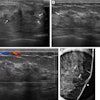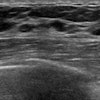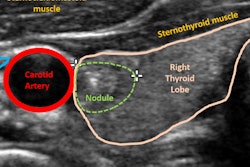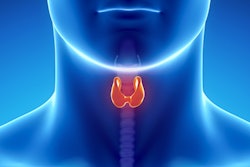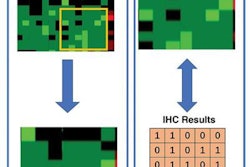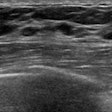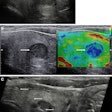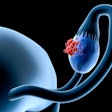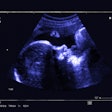
Although it doesn't perform as well as a sonography expert, ultrasound computer-aided diagnosis (CADx) software can still be useful for stratifying thyroid nodules by their risk of malignancy, according to research published online April 11 in the American Journal of Roentgenology.
A team of researchers led by Dr. Jordi Reverter, PhD, of the Autonomous University of Barcelona in Badalona, Spain, found that a commercially available ultrasound CADx software application produced similar sensitivity and negative predictive value to an experienced endocrinologist in analysis of 300 thyroid nodules. It did, however, have lower specificity and positive predictive value.
"Given the high sensitivity and [negative predictive value] that we reported (at least for preliminary screening procedures), such systems could conceivably allow image classification of thyroid nodules as benign or malignant to be performed by a nonexpert operator such as a technician, although the final risk classification should be made by an experienced professional," the authors wrote.
Seeking to assess the performance of the AmCAD-UT software (AmCad BioMed) as a diagnostic aid, the researchers retrospectively gathered ultrasound images of 300 thyroid nodules in patients from the endocrinology service of their large public teaching hospital. Of the 300 nodules, 135 were malignant. The mean maximum nodule diameter was 3.2 ± 1.0 cm for malignant nodules and 2.8 ± 0.4 cm for benign nodules.
A senior staff endocrinologist with 10 years of experience in diagnostic and therapeutic thyroid ultrasound procedures reviewed all of the images and assigned each a suspicion of malignancy score based on the American Thyroid Association (ATA) system. The CADx software was then applied to categorize the images based on the ATA system, the European Thyroid Imaging Reporting and Data System (EU-TIRADS), and the system jointly proposed by the American Association of Clinical Endocrinologists (AACE), the American College of Endocrinology (ACE), and the Associazione Medici Endocrinologi (AME). The researchers then compared the CADx software's results with the endocrinologist's ratings.
| Performance for classifying risk of thyroid nodules | ||||
| CADx software based on AACE/ACE/AME classification system | CADx software based on EU-TIRADS classification system | CADx software based on ATA classification system | Clinical expert using ATA classification system | |
| Sensitivity | 81.5% | 85.2% | 87% | 87% |
| Specificity | 53.2% | 50.2% | 68.8% | 91.2% |
| Positive predictive value | 51.8% | 50.1% | 64.5% | 90.5% |
| Negative predictive value | 80.8% | 82.6% | 86.3% | 90.9% |
| Area under the curve | 0.70 | 0.71 | 0.72 | 0.88 |
The CADx software performed best when applying the ATA reporting system, yielding statistically similar sensitivity and negative predictive value to the clinical expert. However, its specificity and positive predictive value were significantly lower (p < 0.01).
"The fact that an expert would achieve superior results is unsurprising, given that the CADx system learns from the accumulated expertise of imaging experts, which is stored in its database," the authors wrote.
The researchers concluded, however, that the software was reliable and easy to use, making it useful in clinical practice.

